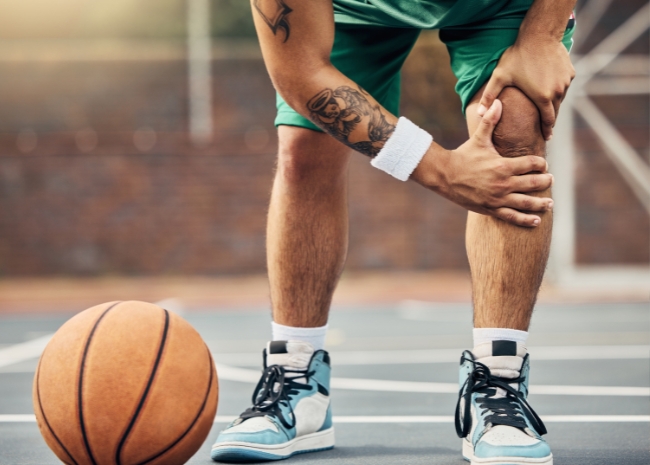
Sports Injury Care and Prevention: Your Comprehensive Guide
Whether you’re a weekend warrior, a high school athlete, or someone who just loves to stay active, one thing’s for sure—sports injuries can happen to anyone.
They can sneak up on you when you least expect them, and suddenly, you’re sidelined from the activities you love.
But here’s the good news: most sports injuries are preventable. And if you’re already dealing with one, there are smart, science-backed ways to recover faster and get back in the game safely.
In this complete guide to sports injury prevention and recovery, we’ll dive into:
- What is a sports injury
- Causes of sports injuries
- Sports injury prevention tips
- Recovery strategies
- FAQs
What is a Sports Injury?
A sports injury refers to any kind of injury that occurs during physical activity—whether you’re playing organized sports, working out at the gym, or just having fun outdoors.
These injuries can range from mild muscle strains to more serious conditions like torn ligaments or broken bones.
Some common examples include:
- Sprained ankles
- Knee injuries (like ACL tears)
- Shin splints
- Tennis elbow
- Pulled hamstrings
Understanding how these injuries happen (and how to avoid them) is key to staying healthy and active.
5 Causes of Sports Injuries
Before we get into prevention and recovery, let’s look at five of the most common causes of sports injuries:
1) Overuse
This is a big one.
When you perform the same movements repeatedly—like running or pitching a baseball—you risk wearing down your muscles, tendons, and joints over time.
This leads to overuse injuries like tendinitis and stress fractures.
2) Poor Technique
Using improper form during exercise or sports not only makes your movements less efficient, but it also puts unnecessary strain on your body.
Think of bad lifting posture or running with improper footwear—both can increase injury risk.
3) Inadequate Warm-up
Skipping a proper warm-up is like hitting the highway without warming up your car in freezing weather.
Cold, tight muscles are more prone to injury. A good warm-up increases blood flow, boosts flexibility, and preps your body for movement.
4) Lack of Conditioning
If your muscles aren’t strong or flexible enough for the demands of your activity, you’re more likely to get hurt.
Conditioning helps prepare your body to handle the stress of movement and impact.
5) Contact and Collisions
In contact sports like football, soccer, or hockey, collisions with other players are part of the game—but they’re also a common cause of injuries like concussions, fractures, and ligament tears.
How to Prevent Sports Injuries: Tips that Actually Work
The best injury is the one that never happens.
Here are practical, effective tips for sports injury prevention:
1) Warm Up Properly
- Spend 5–10 minutes warming up before any physical activity.
- Start with light cardio (jogging, jump rope), then ease into dynamic stretches like leg swings, arm circles, or walking lunges.
2) Improve Flexibility
- Tight muscles limit your range of motion and make you more injury-prone.
- Incorporate static stretching and mobility work into your routine—especially after workouts.
3) Strengthen Your Core and Supporting Muscles
- Your core is the foundation for almost all movement.
- A strong core stabilizes your body, protects your spine, and reduces the risk of overcompensation injuries.
- Don’t forget stabilizing muscles like the glutes, hips, and shoulders.
4) Wear Proper Gear
- From supportive running shoes to braces and mouthguards, wearing the right equipment for your sport can significantly reduce your injury risk.
5) Get Enough Rest
- Your body needs time to recover and rebuild.
- Avoid overtraining and make sure you’re getting quality sleep.
- Schedule at least one rest day per week.
6) Listen to Your Body
- Pain is your body’s way of saying something’s wrong.
- Don’t push through sharp or lingering pain—it’s a recipe for long-term injury.
Sports Injury Recovery: What to Do When You’re Hurt
Even with the best prevention strategies, injuries can still happen. So what should you do if you’re sidelined?
1) First: Don’t Panic
Injuries are frustrating, but they don’t mean you’re out forever.
In most cases, proper care and smart recovery will get you back on track faster than you think.
2) Follow R.I.C.E. for Minor Injuries
For sprains, strains, or minor injuries, the tried-and-true R.I.C.E. method still works:
- Rest – Stop activity to prevent further injury
- Ice – Apply ice 15–20 mins at a time to reduce swelling
- Compression – Use a wrap or bandage to control inflammation
- Elevation – Raise the injured area to limit swelling
3) See a Medical Professional When Needed
If your pain is severe, persistent, or involves a joint, it’s best to consult a sports medicine doctor or physical therapist.
Early diagnosis can prevent complications and speed up healing.
4) Rehab Smart, Not Fast
Take your time with sports injury recovery.
Rushing the healing process can lead to reinjury or chronic issues. Follow your rehab plan, stay consistent, and focus on progress, not perfection.
5) Ease Back Into Activity
Don’t go from zero to 100.
Once cleared by your doctor or therapist, start slow and gradually increase intensity. Keep doing your rehab exercises even after you’re back in action.
Common Questions About Sports Injury Recovery
1) How long does it take to recover from a sports injury?
It depends on the type and severity of the injury.
Minor sprains may heal in a few days, while ligament tears or fractures could take weeks or months. A physical therapist can help you gauge your personal timeline.
2) Can I still work out with a sports injury?
Yes—but only if you’re smart about it.
Avoid using the injured area, and focus on exercises that don’t cause pain. For example, if you have a shoulder injury, you might still be able to ride a stationary bike or train your legs.
3) Do I need physical therapy?
If your injury is moderate to severe, or if you’re not recovering as expected, physical therapy can be a game changer.
A physical therapist can create a personalized recovery plan and help you regain strength, mobility, and function faster.
4) Should I use heat or ice?
In general, use ice during the first 24–72 hours to reduce swelling. After that, heat can help relax tight muscles and increase blood flow for healing.
Always ask your healthcare provider what’s best for your situation.
Recap: Your Game Plan for Injury-Free Performance
Staying active and playing sports is one of the best things you can do for your physical and mental health—but don’t let injuries sideline your progress.
Here’s your quick recap for sports injury prevention and recovery:
✅ Prevention:
- Warm up before workouts
- Strengthen your core and joints
- Improve flexibility
- Use proper gear
- Rest and recover
✅ Recovery:
- R.I.C.E. method for minor injuries
- Get professional help when needed
- Follow a smart rehab plan
- Ease back into activity gradually
Final Thoughts
You don’t need to be a pro athlete to treat your body like one. Whether you’re hitting the trails, the court, or the weight room, taking care of your joints, muscles, and overall health pays off in the long run.
Use these sports injury prevention and recovery tips to stay in the game—and enjoy every minute of it.
Got a nagging injury or unsure how to prevent one? Reach out to us today! Let’s keep you moving, safely and confidently.
Learn about our Performance Services: https://thejacksonclinics.com/services/specialty-services/performance-services/
Want us to come to you? Check out a Jackson Clinics partner, TJC Concierge (Expert care on your time, on your turf!): https://tjcconcierge.com/sports-physical-therapy/
The Jackson Clinics serves 18 locations throughout Northern Virginia.
Find one near you: thejacksonclinics.com/locations










